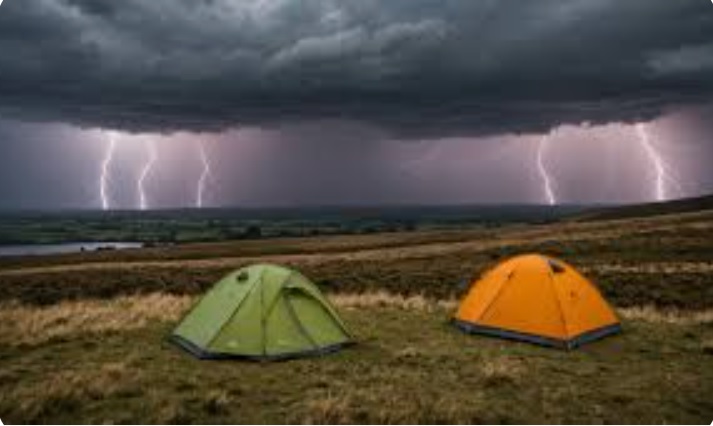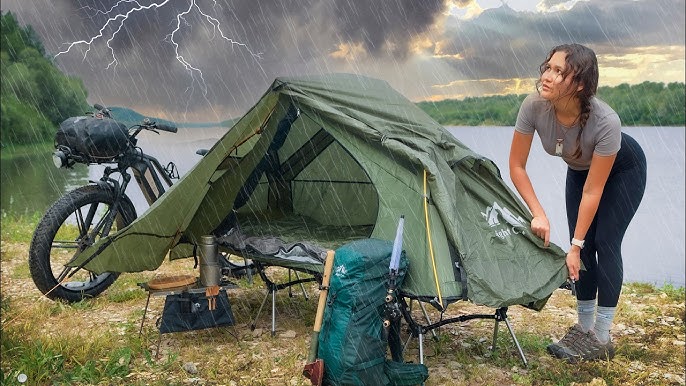Imagine you’re deep in the wilderness, rain pouring down and thunder roaring all around. You’re tucked inside your tent, but a question nags at you: Can you really stay safe camping in a tent during a thunderstorm?
Your safety and peace of mind depend on the answer. You’ll discover crucial facts and smart tips that could protect you from danger when the skies turn dark. Keep reading to learn exactly what you need to know before the next storm hits your campsite.
Risks Of Camping In Thunderstorms
Camping during a thunderstorm can be very dangerous. Tents offer little protection from storm hazards. It is important to know the risks before camping in bad weather.
Thunderstorms bring strong winds, heavy rain, and lightning. These can cause injuries or damage to your campsite. Understanding these dangers helps you stay safe.
Lightning Strikes And Their Dangers
Lightning can strike anywhere, even near your tent. Tents do not protect you from lightning. Being in an open area during a storm increases the risk of a strike.
Lightning strikes can cause serious injury or death. Metal tent poles and camping gear can attract lightning. Avoid tall trees or isolated objects that can be struck.
Flooding And Mudslide Hazards
Heavy rain can cause sudden flooding around your campsite. Tents set up in low areas can fill with water quickly. Floodwaters can sweep away tents and gear.
Steep slopes near your camp can trigger mudslides. Mudslides move fast and can bury your tent. Check your campsite location for flood or mudslide risks.
- Camp on high ground away from rivers or streams
- Avoid camping below steep hills or cliffs
- Clear drainage paths around your tent
Wind And Falling Debris
Thunderstorms often bring strong, gusty winds. These winds can tear tents or blow them away. Loose items can become dangerous flying objects.
Trees and branches can break in high winds. Falling debris can hit your tent or cause injury. Avoid camping near tall trees or dead branches.
- Secure all tent stakes and guy lines firmly
- Keep your area free of loose objects
- Choose open areas away from tall trees

Credit: www.reddit.com
Choosing A Safe Campsite
Camping during a thunderstorm can be dangerous if you do not pick the right spot. Your choice of campsite plays a big role in keeping you safe from lightning and strong winds.
It is important to know where to avoid and where to set up your tent for the best protection. This guide will help you find the safest place to camp in bad weather.
Avoiding High Ground And Isolated Trees
Do not camp on top of hills or ridges during a thunderstorm. Lightning often strikes the highest points in the area. This puts you at great risk if you stay there.
Avoid camping near single tall trees. These trees stand out and are more likely to attract lightning. Instead, find a spot with many trees of similar height.
- Stay away from hilltops and ridges
- Do not camp under lone tall trees
- Look for areas with groups of trees
Selecting Flat And Elevated Areas
Choose flat ground to set up your tent. Flat areas reduce the chance of water pooling and make your tent more stable in strong winds.
Pick places that are slightly elevated but not the highest point. This helps avoid flooding while keeping you safe from lightning strikes.
- Look for flat, stable ground
- Choose slightly raised spots, not peaks
- Check the ground for good drainage
Checking For Nearby Water Bodies
Do not camp too close to rivers, lakes, or ponds during a storm. Water can rise quickly and cause flooding. It also conducts electricity, increasing risk from lightning.
Keep a safe distance from all water sources. Make sure your campsite is uphill from any water bodies to avoid getting caught in a flood.
- Stay away from rivers, lakes, and ponds
- Pick spots uphill from water bodies
- Watch for signs of rising water
Tent Setup For Storm Conditions
Camping during a thunderstorm requires careful tent setup. Proper preparation keeps you safe and dry.
Focus on ground insulation, securing anchors, and positioning the tent correctly to handle storm conditions.
Using Ground Insulation
Ground insulation stops cold and wet air from reaching you inside the tent. It also protects the tent floor.
Use foam pads or thick blankets under your sleeping area. Avoid thin or wet materials that lose insulation value.
- Place a waterproof tarp beneath the tent floor
- Use closed-cell foam pads for best insulation
- Add extra blankets for warmth if needed
Securing Tent Anchors
Strong tent anchors keep your tent stable in heavy wind and rain. Loose anchors can cause damage or collapse.
Use heavy-duty stakes and tie down all guy lines tightly. Check anchors often during the storm.
- Drive stakes deep into firm ground
- Use extra guy lines for added support
- Cross guy lines to improve tension
- Check tension regularly and adjust as needed
Positioning The Tent Properly
Place the tent where water won’t pool or flow under it. Avoid low spots and areas near trees that may fall.
Face the tent entrance away from the wind. Position the tent on higher ground with natural windbreaks if possible.
- Choose flat, elevated ground
- Avoid spots below hills or cliffs
- Keep distance from large trees or dead branches
- Set tent entrance opposite to wind direction
Essential Gear For Thunderstorms
Camping in a tent during a thunderstorm can be dangerous. Having the right gear helps keep you safe and dry.
This guide covers essential items to bring for protection against rain, lightning, and emergencies.
Waterproof Clothing And Gear
Waterproof clothing keeps your body dry and warm during heavy rain. It prevents chills and hypothermia.
Essential waterproof gear includes jackets, pants, boots, and rain covers for your backpack and tent.
- Rain jacket with a hood
- Waterproof pants
- Waterproof boots or shoes
- Rain cover for your backpack
- Tent with a rainfly and sealed seams
Emergency Lightning Protection
Lightning is a major risk during thunderstorms. You need tools and knowledge to stay safe.
Avoid tall objects and open fields. Carry a lightning safety device or follow safety rules.
- Lightning safety whistle or alarm
- Know how to find low ground safely
- Avoid metal objects and water
- Stay inside the tent, away from walls
- Use a tent made from non-conductive materials
First Aid And Communication Tools
First aid kits help treat injuries if accidents happen. Communication tools keep you connected.
Bring a well-stocked first aid kit and devices to call for help if needed.
- Basic first aid kit with bandages and antiseptics
- Emergency blanket for warmth
- Fully charged mobile phone or satellite phone
- Portable power bank for charging devices
- Whistle to signal for help
Behavior During A Thunderstorm
Camping in a tent during a thunderstorm can be dangerous. Knowing how to act helps keep you safe.
Understanding the right behavior during a storm reduces risks. Stay calm and follow safety tips.
Recognizing Early Warning Signs
Thunderstorms often show signs before they arrive. Spotting these early helps you prepare.
Look for dark clouds, sudden wind changes, or distant thunder. These signs mean a storm is near.
- Dark, heavy clouds gathering above
- Wind picking up quickly
- Thunder sounds in the distance
- Sudden drop in temperature
- Lightning flashes in the sky
Safe Actions Inside The Tent
Stay inside your tent, but avoid touching metal parts. Metal can attract lightning.
Keep away from wet areas in the tent and do not use electronic devices. Stay low and calm.
- Stay inside the tent until the storm passes
- Keep away from metal poles and zippers
- Do not use phones or other electronics
- Keep the tent floor dry and avoid puddles
- Stay low to reduce lightning risk
When To Evacuate The Campsite
Leave your campsite if the storm worsens or lightning strikes nearby. Safety is the top priority.
Find a safe shelter away from tall trees and open fields. Do not wait too long to move.
- Evacuate if lightning strikes close to your tent
- Leave if heavy rain causes flooding
- Move if strong winds threaten your tent
- Find a building or vehicle for shelter
- Never shelter under isolated trees or tall objects

Credit: m.youtube.com
After The Storm
Camping during a thunderstorm can be risky. Once the storm ends, you must act carefully. This helps keep you and your gear safe.
Checking your tent, surroundings, and planning your next steps is very important. Follow these tips to stay safe after a storm.
Inspecting Tent And Equipment
Look over your tent for holes or tears caused by wind or rain. Check if poles or stakes are broken or loose.
Wet gear can cause discomfort and damage. Dry your sleeping bags, clothes, and other equipment as soon as possible.
- Check tent fabric for holes or tears
- Make sure poles and stakes are secure
- Dry sleeping bags and clothes thoroughly
- Look for water pooling inside the tent
Checking Surroundings For Hazards
Storms can change the landscape around your campsite. Check for fallen trees, loose branches, or flooded areas.
Look for slippery or unstable ground. Avoid areas with new water flows or deep puddles to prevent accidents.
- Look for fallen trees or broken branches
- Avoid flooded or muddy spots
- Check for slippery rocks or slopes
- Stay away from unstable ground
Planning For Safe Departure
Plan your exit carefully to avoid any hazards left by the storm. Choose a safe route away from water or damaged trees.
Inform your group about the plan. Move slowly and watch your steps. Keep your gear dry and secure during the trip out.
- Pick a safe path away from hazards
- Tell others your departure plan
- Move carefully to avoid slips or falls
- Keep gear dry and packed properly

Credit: www.youtube.com
Frequently Asked Questions
Is It Safe To Camp In A Thunderstorm?
Camping in a thunderstorm is not safe. Tents offer no protection from lightning. Seek shelter in a sturdy building or vehicle. Avoid open fields and tall objects. Always check weather forecasts before camping.
What Should You Do If Caught In A Thunderstorm?
If caught in a thunderstorm, find shelter immediately. Avoid trees, hilltops, and open areas. If no shelter is available, crouch down low with feet together. Stay away from water and metal objects.
Can A Tent Protect You From Lightning?
A tent cannot protect you from lightning. Tents are not grounded and offer no electrical safety. It’s essential to seek proper shelter during a thunderstorm. Always prioritize safety over convenience when camping in such conditions.
How Can You Prepare For Thunderstorms While Camping?
To prepare, always check weather forecasts before your trip. Pack emergency supplies like a weather radio and first aid kit. Choose campsites with nearby shelters. Avoid setting up tents under tall trees or in open fields.
Conclusion
Camping in a tent during a thunderstorm is risky. Lightning can strike nearby, causing serious danger. Always choose a safe place away from tall trees and metal objects. Use a weather app to check forecasts before camping. Stay inside the tent and avoid touching metal parts.
Prepare an emergency plan just in case. Safety comes first when storms arrive. Camping can be fun, but never take chances with storms. Stay alert, stay safe, and enjoy your outdoor adventure wisely.

